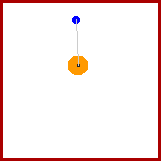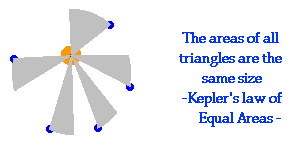Kepler's Second Law
After studying a wealth of planetary data for the motion of the planets about the sun, Johannes Kepler proposed three laws of planetary motion. Kepler's second law states
An imaginary line joining a planet and the sun sweeps out an equal area of space in equal amounts of time.
The animation below depicts the elliptical orbit of a planet about the sun.

The dot pattern shows that as the planet is closest the sun, the planet is moving fastest and as the planet is farthest from the sun, it is moving slowest. Nonetheless, the imaginary line joining the center of the planet to the center of the sun sweeps out the same amount of area in each equal interval of time.

For more information on physical descriptions of motion, visit The Physics Classroom Tutorial. Detailed information is available about the following topics:
Ticker Tape Patterns
Kepler's Three Laws
Circular Motion Principles for Satellites